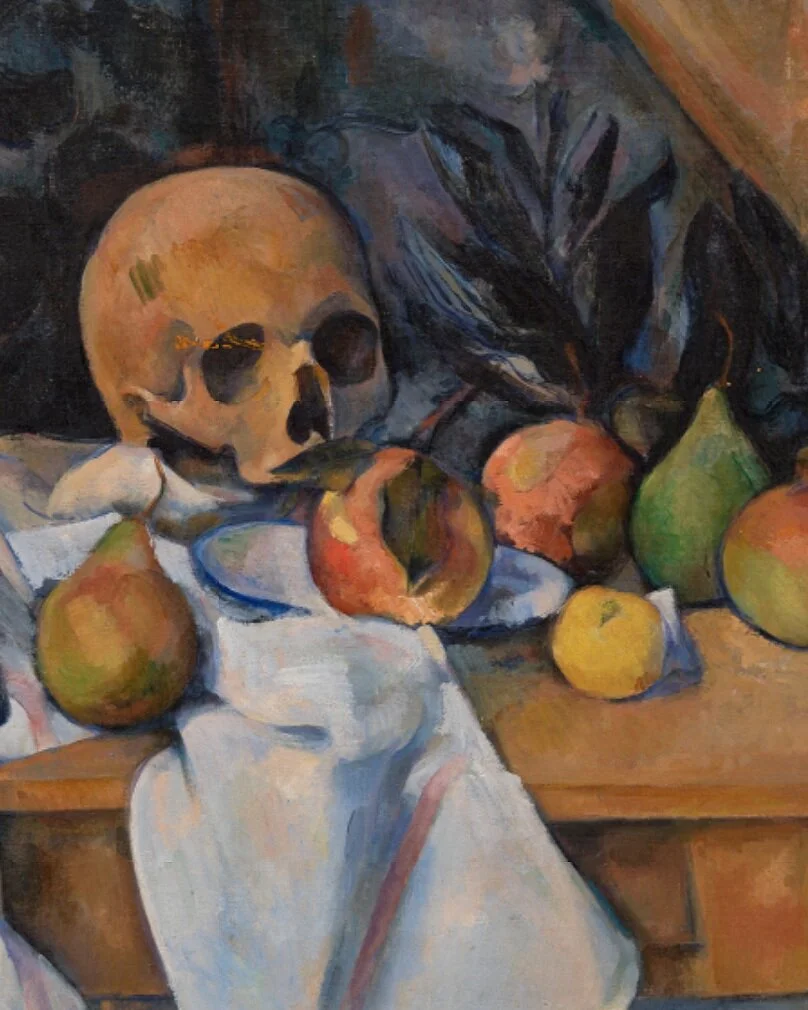Rx 5 / Madame Cézanne
My wife only cares for Switzerland and lemonade.
— Paul Cézanne
Wife and muse Madame Cézanne remains an opaque, diminished figure in the art world. Née Marie-Hortense Fiquet, “Hortense” means “hydrangea” yet this unsuitably named saturnine sitter appears composed, motionless, and bored in over forty of Paul Cézanne’s (1839-1906) portraits, drawings, and watercolors. Here, she is painted in a predominantly cool palette of blues and greens, complemented by warmer hues of umbers and pinks that vertically cap and contain the figure. Her signature tight bun (there is only one portrait of Mme Cézanne with her hair down) elongates pictorial height. Crossed arms enclose the figure, emphasizing an overall pyramidal form. Her face is mask-like and anonymous.
The couple first met in 1869 — she was nineteen years old and working as a bookbinder, Cézanne eleven years her senior. Claiming his authoritarian father would disinherit him, Cézanne insisted their relationship and eventual child remain a subterfuge from his family for over a decade. They married after more than fifteen years of secrecy, likely to legitimize their son as heir to the Cézanne estate, but continued their baseline marital separation - Mme Cézanne in Paris with Paul Jr., Cézanne at his family home in Aix-en-Provence. Nicknamed “La Boule” or “the ball” for her notoriously orb-shaped head, Mme Cézanne was ridiculed and belittled by Cézanne’s friends for her sullen, matronly visage and taciturn demeanor. Baseless rumors such as her absence at Cézanne’s deathbed due to a pressing dressmaker appointment in Paris further maligned her as a discontented, self-possessed shrew. At the time of his death in 1906, Cézanne had written her out of his will.
Known for his distinctly ‘anti-biography’ approach to portraiture and agonizingly slow painterly process, Mme Cézanne would pose for hours while her husband painstakingly deliberated every detail, sometimes pausing for over twenty minutes from one brush stroke to the next. Yet the time intensive portraits reveal little about her true nature or the emotional tenor of the marriage. Like Mont Sainte-Victoire, Mme Cézanne is as an abiding presence, a landscape rendered without affectation — form over flesh, identity subsumed into objectivity.
Reflections…
In 1889, Sir William Osler delivered his now canonized speech entitled “Aequanimitas” to the graduating medical school class of the University of Pennsylvania. He stressed that “a certain measure of insensibility is not only an advantage, but a positive necessity in the exercise of calm judgment.”
Does Cézanne’s detached, restrained approach to portraiture of even his wife embody a similar spirit of equanimity? Does this method reflect a callous lack of sentimentality and joie de vivre, or a desire for seeking a deeper truth?
Do healthcare providers balance a similarly fine line of acknowledging personhood while maintaining clinical equanimity in the patient encounter? Does that balance tip in any one particular direction depending on the clinical course of the patient or duration of time spent caring for them?
sources
“Madame Cézanne: Exhibition Overview.” The Met 150, www.metmuseum.org/exhibitions/listings/2014/madame-cezanne.
Ofri, Danielle. What Doctors Feel: How Emotions Affect the Practice of Medicine. Boston: Beacon Press, 2013.
Solomon, Deborah. “Take My Wife. S’il Vous Plaît.” The New York Times, 20 Nov. 2014, www.nytimes.com/2014/11/23/arts/design/madame-czanne-at-the-metropolitan-museum.html.
Solomon, Deborah, and Gisele Regateo. “Madame Cezanne: Muse or Object?” WNYC, 27 Nov. 2014, www.wnyc.org/story/madame-cezanne-muse-or-object/.
Trachtman, Paul. “Cézanne: The Man Who Changed the Landscape of Art.” Smithsonian Magazine, Jan. 2006, www.smithsonianmag.com/arts-culture/cezanne-107584544/. Accessed 16 May 2020.
Wilkin, Karen. “Facing Hortense Fiquet.” Wall Street Journal, 17 Dec. 2014, www.wsj.com/articles/art-review-facing-hortense-fiquet-on-madame-cezanne-at-the-metropolitan-museum-of-art-1418861729.







